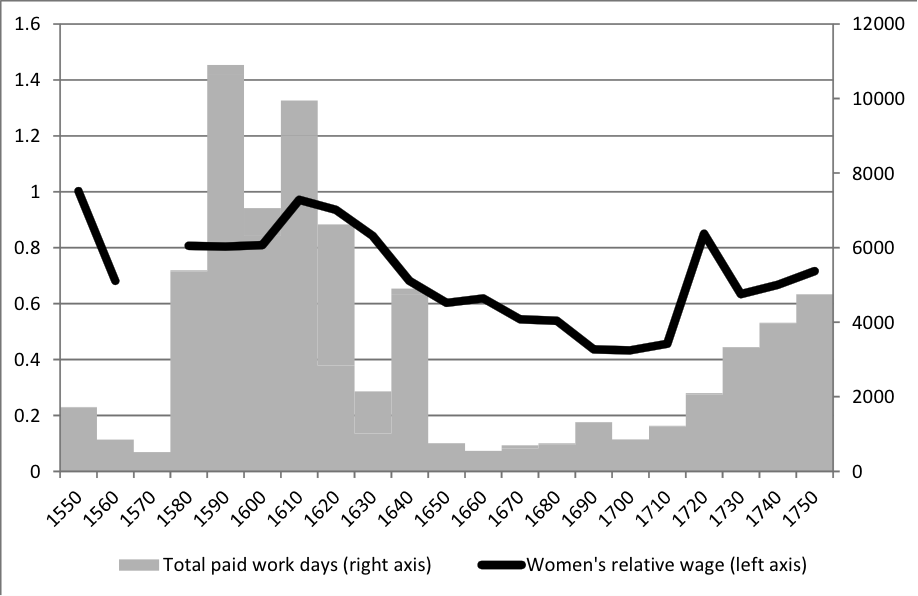Constructing Equality? Women’s wages, physical labor, and demand factors in Sweden 1550-1759
by Kathryn E. Gary, PhD candidate, Lund University
—

Women were important workers in the past, but they are still under-studied and their contributions largely absent from big-picture discussions of historical living standards. This is largely because women’s work remains to some extent a black box, but recent research has both challenged assumptions about how women participated in the paid labor market (c.f. Humphries and Sarasua 2012) and provided data about women’s payment for different kinds of labor (c.f. Humphries and Weisdorf 2015). The current work contributes to both these areas, by creating series of men’s and women’s wages in early modern Sweden, and by exploring both the mechanisms behind the gender gap in pay as well as the conditions under which women enter paid labor, with the goal of better understanding work in the past in general.
Primary data come from unskilled workers in the construction industry in Southern Sweden, predominantly from the towns Malmö and Kalmar; these are combined with published data from Stockholm, also from construction workers (Jansson, Andersson Palm, and Söderberg 1991). All data are for individuals paid by the day; relative wages are simply the percentage of men’s wages that women earn.

Figure 1 shows women’s relative wages from 1550 to 1759. Relative wages are high at the beginning of the period, around 80 percent, and increase to levels of parity in the early 17th century, after which they decline substantially, reaching as low as 40 percent during the end of the seventeenth century and into the eighteenth. This is a substantial decline over the period of not much more than a generation.
Some relative wage peaks are related to events that change both the demand for and supply of labor. Kalmar was a border town between Sweden and Denmark; from 1611 to 1613 the two countries fought the Kalmar War. Following these years women’s wages peaked, likely due to necessary rebuilding and a shortage in the supply of men. There is a wage spike in the same city following a fire in 1647 – while the national average weighs down the peak values, the deviations are still clear in the series, and when Kalmar is examined individually women’s relative wages peak as high as 1.33.


Table 1: Women’s work days as a percentage of all workdays in Kalmar, 1614-1710
Women’s ability to earn high wages goes against many of our theories about women’s earning potential – women are expected to earn less than men in physical tasks, because women are not as strong as men, and so are less productive physical laborers (Burnette 2008). Other theories suggest that women face constant wage discrimination (c.f. Bardsley 1999) – but this, too, is confounded by women’s ability to out-earn men, and by the large changes in the relative wage series. Something else is happening.
To understand we must look more closely at the data. In Kalmar workers are almost universally identifiable, allowing for deeper examination of the workforce. Table 1 shows the percentage of paid workdays that were worked by women, compared with the total number of paid work days in five year periods. Comparing the proportional feminization of the workforce with the amount of work, we see that the periods with the greatest amount of work are those in which the workforce is the most feminized – these periods are also those during which women’s relative wages are highest (see figure 1).
In combination with the relationship between total paid workdays and women’s relative wages across the whole country (figure 2), we are faced with a pattern that is familiar from the first and second world wars – when labor demand is high, women enter the labor force in higher numbers and are able to command higher wages. There is less evidence that women were systematically paid less either due to discrimination or because of their lower productivity – instead, women are responsive to economic forces, and especially to demand forces.

It is simple to to extend our sense of what is ‘traditional’ deep into the past, and to apply broad categories of ‘men’s’ and ‘women’s’ work. However, when we are able to suspend our assumptions and dig deeper into the evidence, the data tell a less expected story; women in Sweden worked in physical occupations, alongside men, often for similar wages. They worked especially hard when the need was highest, and women’s wages only fell away from men’s when work became less regular and men and women weren’t employed together.
Accounting for women’s work shifts our understanding of household living standards in the long run, and provides strong evidence for what is intuitively clear: we cannot truly understand the past if we continue to discount the experiences or contribution of half the population.
The full working paper, ‘Constructing equality?’ is available to view.

